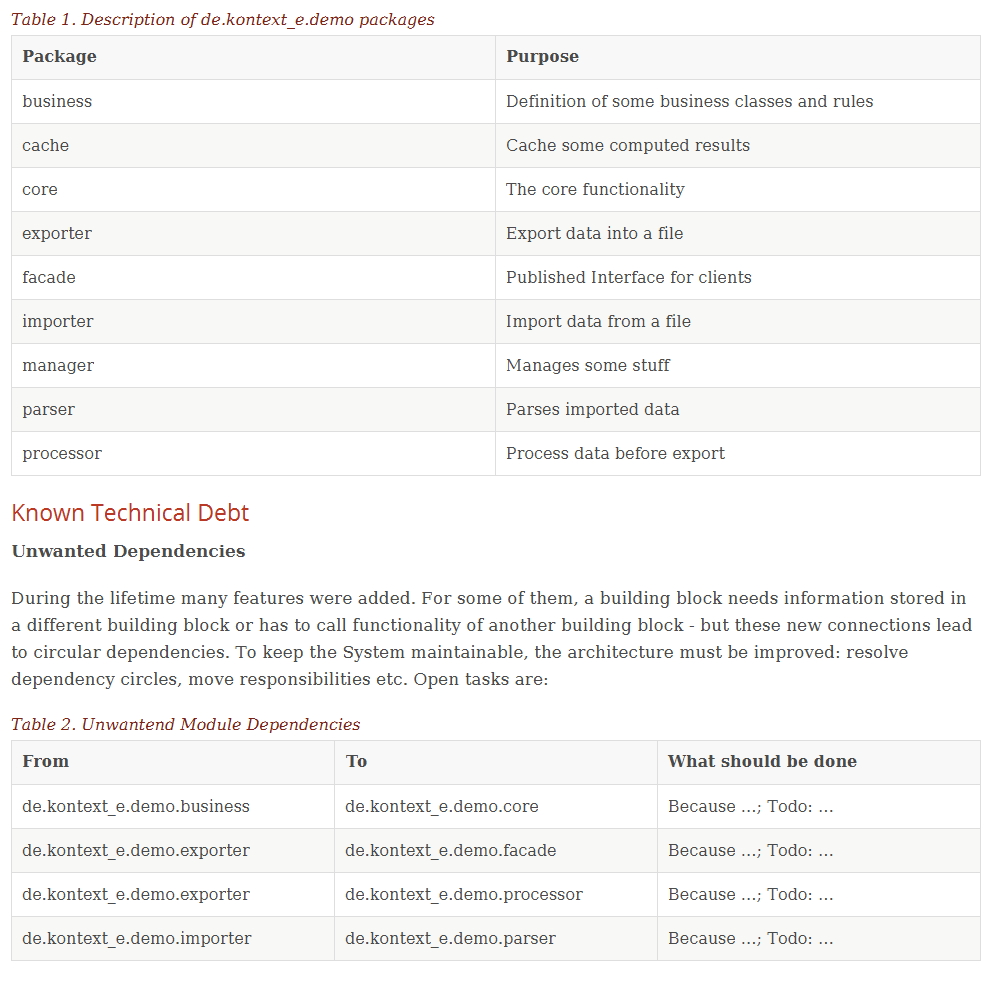In the last post I described in detail how to use the same document to check the defined against the actual architecture. If you tried it out with the example project, you found some dependencies in the wrong direction. And perhaps also in your own projects. This time I’ll show you how to handle this Technical Debt in a way that both the CI build gets green again and it is also documented in the arc42 architecture documentation.
Documenting the unwanted dependencies
To make it visible and clear that there is Technical Debt regarding building block dependencies, it is a good idea to document the unwanted dependencies just below the description of the building blocks and the desired dependencies. I used for that an Asciidoc table like this:
.Unwantend Module Dependencies
[options="header"]
|===
| From | To | What should be done
| de.kontext_e.demo.business | de.kontext_e.demo.core | Because ...; Todo: ...
| de.kontext_e.demo.exporter | de.kontext_e.demo.facade | Because ...; Todo: ...
| de.kontext_e.demo.exporter | de.kontext_e.demo.processor | Because ...; Todo: ...
| de.kontext_e.demo.importer | de.kontext_e.demo.parser | Because ...; Todo: ...
|===
and it gets rendered this way:

In a real project I found it useful the have a third column to describe why the wrong dependency is currently there and to propose refactorings.
Add Asciidoc documents to the jQAssistant database
The freshly released version 1.2.0 of the Kontext E jQAssistant plugin suite contains also a Plugin for reading Asciidoc documents. Note that this plugin uses the same version of AsciidoctorJ as jQAssistant does to prevent runtime conflicts. So this Plugin works only with 1.2+ versions of jQAssistant because former versions use a too old AsciidoctorJ version.
To use the Asciidoc plugin, add it as jQAssistant dependency:
Maven
1
2
3
4
5
<dependency>
<groupId>de.kontext-e.jqassistant.plugin</groupId>
<artifactId>jqassistant.plugin.asciidoc</artifactId>
<version>${jqassistant.kePlugins.version}</version>
</dependency>
Gradle
1
jqaRt("de.kontext-e.jqassistant.plugin:jqassistant.plugin.asciidoc:1.2.0")
The documentation folder is already part of the pathes to be scanned. If it works, you should now have lots of :Asciidoc labeled nodes in your database.
Add a jQAssistant Concept for the Technical Debt
Next thing is to mark dependencies between Java packages as Technical Debt. So I first find our Asciidoc table which I titled “Unwantend Module Dependencies” and use the body:
1
2
3
4
5
6
MATCH
(a:Asciidoc:Table)-[:BODY]->(body)
WHERE
a.title='Unwantend Module Dependencies'
WITH
body
In the first two columns I put the source and target package names, so select them:
1
2
3
4
MATCH
(c1:Asciidoc:Cell {colnumber: 0})<-[:CONTAINS_CELLS]-(body)-[:CONTAINS_CELLS]->(c2:Asciidoc:Cell {colnumber: 1})
WITH
c1, c2
Now I find the matching Java packages:
1
2
3
4
5
6
MATCH
(m1:Java:Package), (m2:Java:Package)
WHERE
m1.fqn = c1.text
AND
m2.fqn = c2.text
and create a relationship between them:
1
2
3
4
MERGE
(m1)-[:TECHNICAL_DEBT]->(m2)
RETURN
m1, m2;
The resulting Cypher query is this:
1
2
3
4
5
6
7
8
9
10
11
12
13
14
15
16
17
18
19
20
MATCH
(a:Asciidoc:Table)-[:BODY]->(body)
WHERE
a.title='Unwantend Module Dependencies'
WITH
body
MATCH
(c1:Asciidoc:Cell {colnumber: 0})<-[:CONTAINS_CELLS]-(body)-[:CONTAINS_CELLS]->(c2:Asciidoc:Cell {colnumber: 1})
WITH
c1, c2
MATCH
(m1:Java:Package), (m2:Java:Package)
WHERE
m1.fqn = c1.text
AND
m2.fqn = c2.text
MERGE
(m1)-[:TECHNICAL_DEBT]->(m2)
RETURN
m1, m2;
Now I can put the query into the jQAssistant rules file. As usual I show examples for Asciidoc as well as for XML.
Asciidoc
[[documented:TechnicalDebt]]
.Creates a relationship between two Packages for Technical Debt.
[source,cypher,role=concept]
----
MATCH
(a:Asciidoc:Table)-[:BODY]->(body)
WHERE
a.title='Unwantend Module Dependencies'
WITH
body
MATCH
(c1:Asciidoc:Cell {colnumber: 0})<-[:CONTAINS_CELLS]-(body)-[:CONTAINS_CELLS]->(c2:Asciidoc:Cell {colnumber: 1})
WITH
c1, c2
MATCH
(m1:Java:Package), (m2:Java:Package)
WHERE
m1.fqn = c1.text
AND
m2.fqn = c2.text
MERGE
(m1)-[:TECHNICAL_DEBT]->(m2)
RETURN
m1, m2;
----
XML
1
2
3
4
5
6
7
8
9
10
11
12
13
14
15
16
17
18
19
20
21
22
23
24
25
26
27
28
29
<concept id="documented:TechnicalDebt">
<description>
Creates a relationship between two Packages for Technical Debt.
</description>
<cypher><![CDATA[
MATCH
(a:Asciidoc:Table)-[:BODY]->(body)
WHERE
a.title='Unwantend Module Dependencies'
WITH
body
MATCH
(c1:Asciidoc:Cell {colnumber: 0})
<-[:CONTAINS_CELLS]-(body)-[:CONTAINS_CELLS]->
(c2:Asciidoc:Cell {colnumber: 1})
WITH
c1, c2
MATCH
(m1:Java:Package), (m2:Java:Package)
WHERE
m1.fqn = c1.text
AND
m2.fqn = c2.text
MERGE
(m1)-[:TECHNICAL_DEBT]->(m2)
RETURN
m1, m2;
]]></cypher>
</concept>
Modify the jQAssistant Constraint WrongDirection
I modified the Constraint WrongDirection in a way that it also requires “documented:TechnicalDebt” and that the Cypher query excludes documented Technical Debt dependencies:
Asciidoc
[[dependency:WrongDirection]]
.Finds package dependencies which are in the wrong direction according to the documentation.
[source,cypher,role=constraint,requiresConcepts="dependency:TransitivePackageDependencies, documented:TechnicalDebt",severity=critical]
----
MATCH
(p1:PlantUml:Package)-[:MAY_DEPEND_ON]->(p2:PlantUml:Package),
(p3:Java:Package)-[:DEPENDS_ON]->(p4:Java:Package)
WHERE
p1.fqn = p4.fqn
AND p2.fqn = p3.fqn
AND NOT (p3)-[:TECHNICAL_DEBT]->(p4)
RETURN
p3.fqn + "-->" + p4.fqn AS WrongDirection;
----
XML
1
2
3
4
5
6
7
8
9
10
11
12
13
14
15
16
17
18
19
20
<constraint id="dependency:WrongDirection" severity="critical">
<requiresConcept refId="dependency:Package"/>
<requiresConcept refId="dependency:TransitivePackageDependencies"/>
<requiresConcept refId="dependency:WrongDirection"/>
<description>
Finds package dependencies which are in the wrong direction
according to the documentation.
</description>
<cypher><![CDATA[
MATCH
(p1:PlantUml:Package)-[:MAY_DEPEND_ON]->(p2:PlantUml:Package),
(p3:Java:Package)-[:DEPENDS_ON]->(p4:Java:Package)
WHERE
p1.fqn = p4.fqn
AND p2.fqn = p3.fqn
AND NOT (p3)-[:TECHNICAL_DEBT]->(p4)
RETURN
p3.fqn + "-->" + p4.fqn AS WrongDirection;
]]></cypher>
</constraint>
Running the checks again
If you run the checks in the example project again, the four constraint violations should be gone.
Some closing words
If dependencies in a project got never checked, there are most like unwanted dependencies. Not surprising and it also hit me with the C++ project I wrote about Breaking the build with any wrong dependency makes the build red for a long time. Resolving those dependencies is not a five minute task. But documenting them and defining exceptions from the dependency architecture rules with exactly the same table gives us a good chance to improve the architecture step by step over several iterations.
As you may have guessed from the title, more posts about handling Technical Debt are in the pipeline. But before that, I have to introduce you to some other things first.